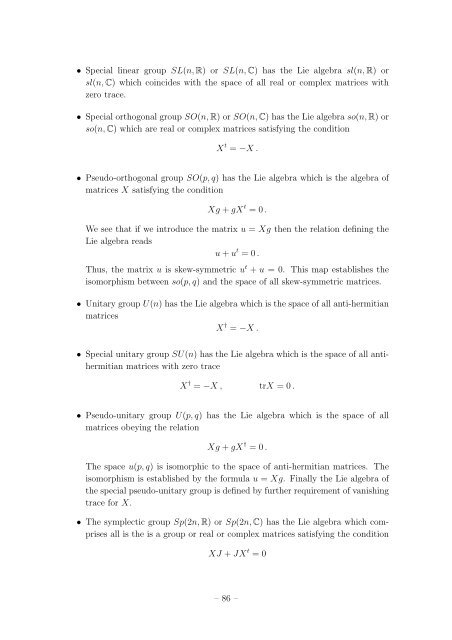Student Seminar: Classical and Quantum Integrable Systems
Student Seminar: Classical and Quantum Integrable Systems
Student Seminar: Classical and Quantum Integrable Systems
Create successful ePaper yourself
Turn your PDF publications into a flip-book with our unique Google optimized e-Paper software.
• Special linear group SL(n, R) or SL(n, C) has the Lie algebra sl(n, R) or<br />
sl(n, C) which coincides with the space of all real or complex matrices with<br />
zero trace.<br />
• Special orthogonal group SO(n, R) or SO(n, C) has the Lie algebra so(n, R) or<br />
so(n, C) which are real or complex matrices satisfying the condition<br />
X t = −X .<br />
• Pseudo-orthogonal group SO(p, q) has the Lie algebra which is the algebra of<br />
matrices X satisfying the condition<br />
Xg + gX t = 0 .<br />
We see that if we introduce the matrix u = Xg then the relation defining the<br />
Lie algebra reads<br />
u + u t = 0 .<br />
Thus, the matrix u is skew-symmetric u t + u = 0. This map establishes the<br />
isomorphism between so(p, q) <strong>and</strong> the space of all skew-symmetric matrices.<br />
• Unitary group U(n) has the Lie algebra which is the space of all anti-hermitian<br />
matrices<br />
X † = −X .<br />
• Special unitary group SU(n) has the Lie algebra which is the space of all antihermitian<br />
matrices with zero trace<br />
X † = −X , trX = 0 .<br />
• Pseudo-unitary group U(p, q) has the Lie algebra which is the space of all<br />
matrices obeying the relation<br />
Xg + gX † = 0 .<br />
The space u(p, q) is isomorphic to the space of anti-hermitian matrices. The<br />
isomorphism is established by the formula u = Xg. Finally the Lie algebra of<br />
the special pseudo-unitary group is defined by further requirement of vanishing<br />
trace for X.<br />
• The symplectic group Sp(2n, R) or Sp(2n, C) has the Lie algebra which comprises<br />
all is the is a group or real or complex matrices satisfying the condition<br />
XJ + JX t = 0<br />
– 86 –

















